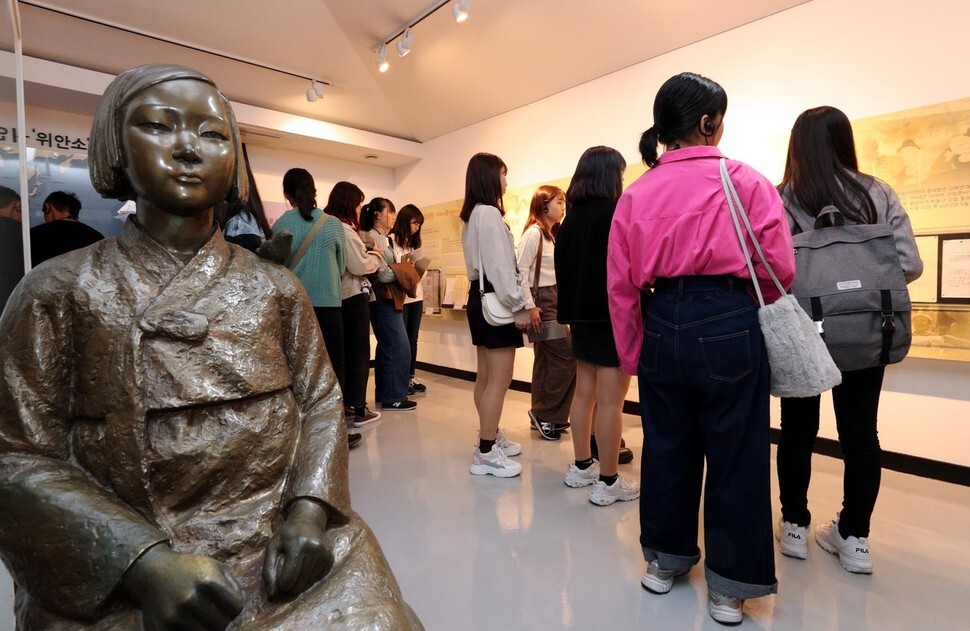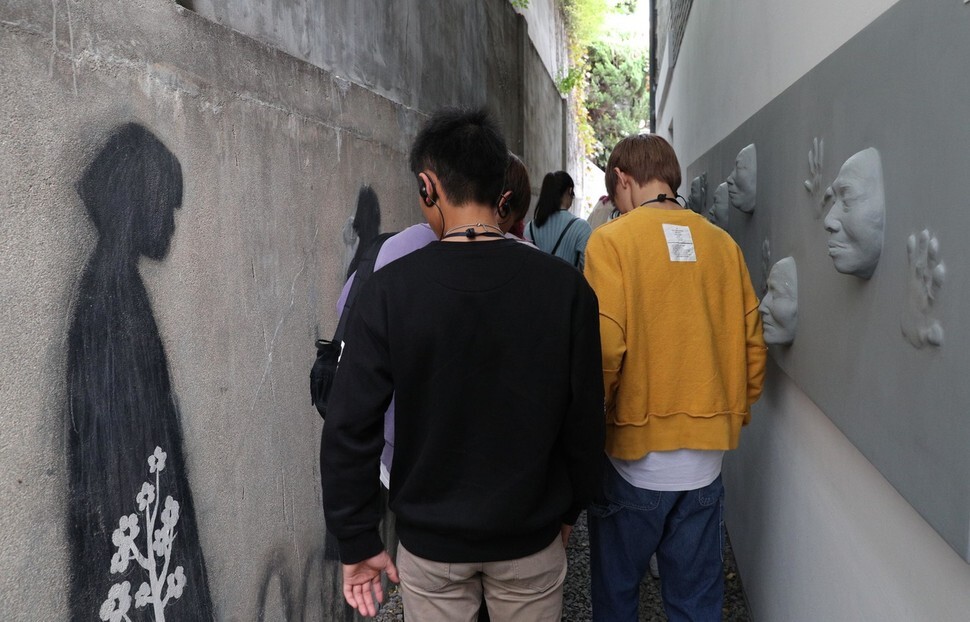hankyoreh
Links to other country sites 다른 나라 사이트 링크
Japanese high-school students visit S. Korea to learn about historical issues

“I never heard about South Koreans’ painful history on Twitter or the internet. There’s so much inaccurate information. [. . .] It was really difficult for me to come to Korea and hear for myself about what the comfort women went through.”
Takahiro Hosoya, a 17-year-old second year student at a high school affiliated with Japan’s Chuo University, teared up as he recalled the moment when he first encountered a statue of a young girl in Seoul’s Jongno District representing the victims of Japanese military sexual slavery. Hosoya kept his gaze directed downward throughout the interview on Oct. 22 at the Democracy and Human Rights Memorial Hall (a former Namyeong anti-communist investigation office) in the Namyeong neighborhood of Seoul’s Yongsan District.
With South Korea-Japan relations recently strained in the wake of economic retaliation measures by the Shinzo Abe administration, 40 Japanese high school students arrived on Oct. 21 on a four-day visit for a “Korea-Japan history research tour.” The students volunteered for a “Korean history journey” as part of a general education program. The course was instituted last year by Ko Hwa-jeong, a 43-year-old Zainichi Korean teacher of Japanese; this year’s history trip was the second to date.
While last year’s visit centered on historical records of the Japanese occupation, this year’s added settings where the students could learn about South Korea’s modern history, including the former anti-communist investigation office in the city’s Namyeong neighborhood. Students also watched the film “1987: When the Day Comes,” based on the office’s unlawful investigations and torture of people arbitrarily labeled as communists, before their visit.
“I thought it would be good for the students to learn about history like the dominant role played by pro-Japanese collaborators during the military administrations of the 1980s and 1990s,” Ko explained, describing the Namyeong office as an “important place linking South Korea’s past to its present.”
After wordlessly viewing a room used for torture on the office’s fifth floor, Asumi Inoue, 17, said, “I’ve learned a lot of things I didn’t know over these two days of studying South Korea’s history.”

Abe needs to “acknowledge historical facts” at some point
“When I heard about the comfort women being victimized by the Japanese military, I just considered as a woman how horrible that must have been, regardless of nationality,” she added. “It’s going to be important for Prime Minister Abe to acknowledge [historical facts] at some point.”
Hosoya, who shared his fondness for Korean food, said, “When it comes to painful parts of history like the comfort women, most of the people I know either are mistaken about the facts or say extreme things like, ‘If they got paid for it, there’s nothing we can do about it.’”
“I hope to study a bit more about the things I’ve heard [in South Korea] and share them with people I know,” he said.
Before their visit to the anti-communist investigation office, students watched a video provided by the Center for Historical Truth and Justice showing personal accounts from forced labor survivors. They also met Lee Hee-ja, a surviving family member of a forced labor victim during the Japanese occupation whose father is enshrined at Yasukuni Shrine. Yusuke Takatsu, a 17-year-old fan of the Korean girl group Oh My Girl, named the meeting with Lee as the most moving movement of the visit.
“Hearing that story about losing her precious family through the war made me really sense the importance of family, regardless of country,” Takatsu said.
“After hearing what Lee Hee-ja said, I thought it was really unfortunate that we don’t know about the things Japan did in the past,” he added.
After arriving on Oct. 21, the students spent their first day in South Korea visiting Geoncheong Residence – the site of Empress Myeongseong’s assassination – and the comfort women statue. After visiting the Seodaemun Prison History Hall and War and Women's Human Rights Museum on Oct. 23, they returned to Japan on Oct. 24. The “Korea-Japan history research tour” concluded with a group viewing of “Annyeong, Sayonara,” a documentary co-produced by South Korea and Japan on the Yasukuni Shrine issue.
By Kwon Ji-dam, staff reporter
Please direct comments or questions to [english@hani.co.kr]

Editorial・opinion
![[Column] The state is back — but is it in business? [Column] The state is back — but is it in business?](https://flexible.img.hani.co.kr/flexible/normal/500/300/imgdb/original/2024/0506/8217149564092725.jpg) [Column] The state is back — but is it in business?
[Column] The state is back — but is it in business?![[Column] Life on our Trisolaris [Column] Life on our Trisolaris](https://flexible.img.hani.co.kr/flexible/normal/500/300/imgdb/original/2024/0505/4817148682278544.jpg) [Column] Life on our Trisolaris
[Column] Life on our Trisolaris- [Editorial] Penalties for airing allegations against Korea’s first lady endanger free press
- [Editorial] Yoon must halt procurement of SM-3 interceptor missiles
- [Guest essay] Maybe Korea’s rapid population decline is an opportunity, not a crisis
- [Column] Can Yoon steer diplomacy with Russia, China back on track?
- [Column] Season 2 of special prosecutor probe may be coming to Korea soon
- [Column] Park Geun-hye déjà vu in Yoon Suk-yeol
- [Editorial] New weight of N. Korea’s nuclear threats makes dialogue all the more urgent
- [Guest essay] The real reason Korea’s new right wants to dub Rhee a founding father
Most viewed articles
- 1[Column] Why Korea’s hard right is fated to lose
- 2Amid US-China clash, Korea must remember its failures in the 19th century, advises scholar
- 3[Column] The state is back — but is it in business?
- 4[Column] Life on our Trisolaris
- 5AI is catching up with humans at a ‘shocking’ rate
- 6[Guest essay] Maybe Korea’s rapid population decline is an opportunity, not a crisis
- 760% of young Koreans see no need to have kids after marriage
- 8[Column] Can Yoon steer diplomacy with Russia, China back on track?
- 9[Editorial] Yoon must halt procurement of SM-3 interceptor missiles
- 10[Reporter’s notebook] In Min’s world, she’s the artist — and NewJeans is her art